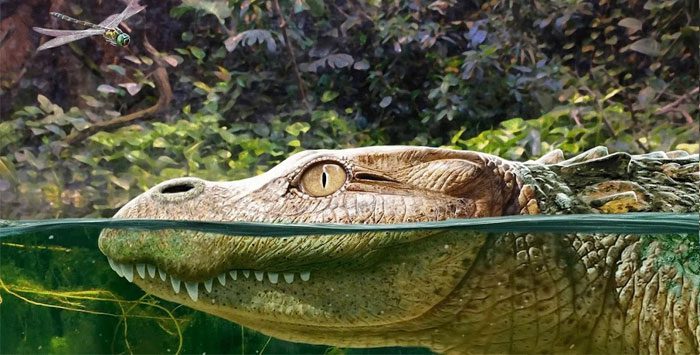A massive fossilized skull of a creature has been discovered in Nakhon Ratchasima Province, Thailand, which does not match any previously known species.
The newly identified species has been named Alligator munensis, as it is classified as an ancient crocodile, despite its “appearance” being quite different from modern crocodiles, featuring a short snout reminiscent of a dinosaur.
According to Sci-News, analyses indicate that Alligator munensis is closely related to the Chinese Alligator (Alligator sinensis), the only living representative outside the Americas of a large group of crocodiles known as Alligatoridae.

Graphic portrait of the new creature from Thailand, featuring skin and body shape similar to modern crocodiles, but with a distinct skull and “appearance” – (Photo: Márton Szabó).
The study, led by paleontologist Gustavo Darlim from Eberhard Karls University Tübingen (Germany), also determined that this skull is 230,000 years old.
It belonged to a creature as large as modern crocodiles but with a wide, short snout and a significantly higher skull. Its number of tooth sockets is also lower, and the nostrils are situated far from the end of the snout.
It shares several unusual characteristics with the Chinese Alligator, including a small hole in the palate, a ridge on the top of the skull, and another ridge behind the nostrils.
The authors suggest that the new monster species and the Chinese Alligator may share a common ancestor that once dominated the lowlands of the Yangtze and Mekong River systems.
“The uplift of the southeastern Tibetan Plateau from 25 to 5 million years ago may have led to the separation of two different populations and the evolution into two distinct species,” states the publication in the journal Scientific Reports.
The large teeth of the Thai creature may have evolved to suit its diet in the Mekong River basin, including hard-shelled species such as snails and clams.
This new discovery provides an important piece in the puzzle of crocodile diversity, one of the “living fossils” that have survived numerous mass extinctions on the planet, showcasing a staggering variety of species, behaviors, and forms.


















































